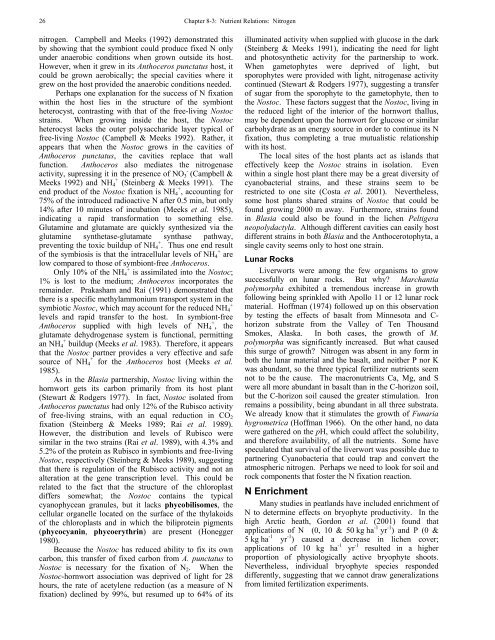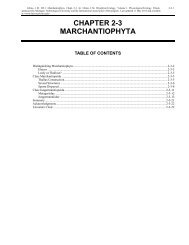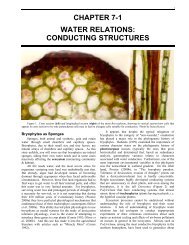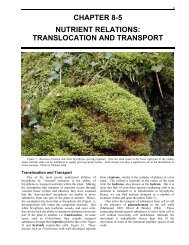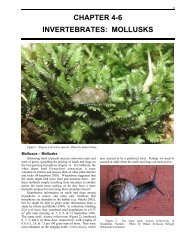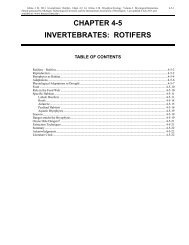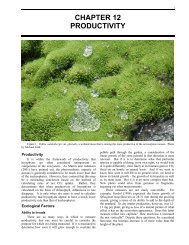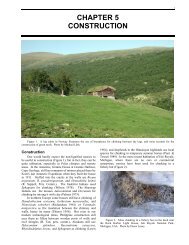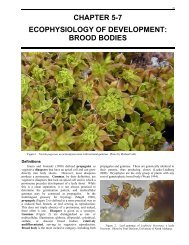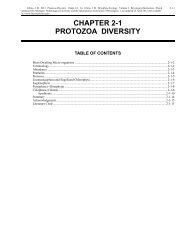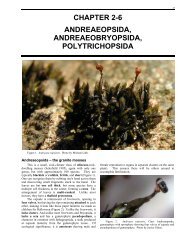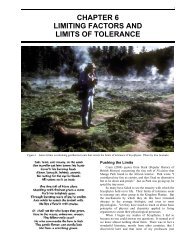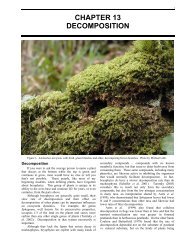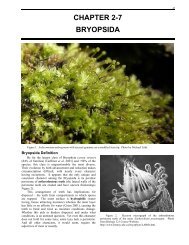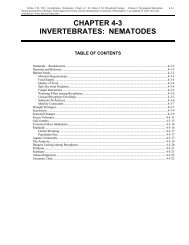chapter 8-3 nutrient relations: nitrogen - Bryophyte Ecology ...
chapter 8-3 nutrient relations: nitrogen - Bryophyte Ecology ...
chapter 8-3 nutrient relations: nitrogen - Bryophyte Ecology ...
You also want an ePaper? Increase the reach of your titles
YUMPU automatically turns print PDFs into web optimized ePapers that Google loves.
26 Chapter 8-3: Nutrient Relations: Nitrogen<br />
<strong>nitrogen</strong>. Campbell and Meeks (1992) demonstrated this<br />
by showing that the symbiont could produce fixed N only<br />
under anaerobic conditions when grown outside its host.<br />
However, when it grew in its Anthoceros punctatus host, it<br />
could be grown aerobically; the special cavities where it<br />
grew on the host provided the anaerobic conditions needed.<br />
Perhaps one explanation for the success of N fixation<br />
within the host lies in the structure of the symbiont<br />
heterocyst, contrasting with that of the free-living Nostoc<br />
strains. When growing inside the host, the Nostoc<br />
heterocyst lacks the outer polysaccharide layer typical of<br />
free-living Nostoc (Campbell & Meeks 1992). Rather, it<br />
appears that when the Nostoc grows in the cavities of<br />
Anthoceros punctatus, the cavities replace that wall<br />
function. Anthoceros also mediates the <strong>nitrogen</strong>ase<br />
activity, supressing it in the presence of NO3 - (Campbell &<br />
Meeks 1992) and NH4 + (Steinberg & Meeks 1991). The<br />
end product of the Nostoc fixation is NH4 + , accounting for<br />
75% of the introduced radioactive N after 0.5 min, but only<br />
14% after 10 minutes of incubation (Meeks et al. 1985),<br />
indicating a rapid transformation to something else.<br />
Glutamine and glutamate are quickly synthesized via the<br />
glutamine synthetase-glutamate synthase pathway,<br />
preventing the toxic buildup of NH4 + . Thus one end result<br />
of the symbiosis is that the intracellular levels of NH4 + are<br />
low compared to those of symbiont-free Anthoceros.<br />
Only 10% of the NH4 + is assimilated into the Nostoc;<br />
1% is lost to the medium; Anthoceros incorporates the<br />
remainder. Prakasham and Rai (1991) demonstrated that<br />
there is a specific methylammonium transport system in the<br />
symbiotic Nostoc, which may account for the reduced NH4 +<br />
levels and rapid transfer to the host. In symbiont-free<br />
Anthoceros supplied with high levels of NH4 + , the<br />
glutamate dehydrogenase system is functional, permitting<br />
an NH4 + buildup (Meeks et al. 1983). Therefore, it appears<br />
that the Nostoc partner provides a very effective and safe<br />
source of NH4 + for the Anthoceros host (Meeks et al.<br />
1985).<br />
As in the Blasia partnership, Nostoc living within the<br />
hornwort gets its carbon primarily from its host plant<br />
(Stewart & Rodgers 1977). In fact, Nostoc isolated from<br />
Anthoceros punctatus had only 12% of the Rubisco activity<br />
of free-living strains, with an equal reduction in CO2<br />
fixation (Steinberg & Meeks 1989; Rai et al. 1989).<br />
However, the distribution and levels of Rubisco were<br />
similar in the two strains (Rai et al. 1989), with 4.3% and<br />
5.2% of the protein as Rubisco in symbionts and free-living<br />
Nostoc, respectively (Steinberg & Meeks 1989), suggesting<br />
that there is regulation of the Rubisco activity and not an<br />
alteration at the gene transcription level. This could be<br />
related to the fact that the structure of the chloroplast<br />
differs somewhat; the Nostoc contains the typical<br />
cyanophycean granules, but it lacks phycobilisomes, the<br />
cellular organelle located on the surface of the thylakoids<br />
of the chloroplasts and in which the biliprotein pigments<br />
(phycocyanin, phycoerythrin) are present (Honegger<br />
1980).<br />
Because the Nostoc has reduced ability to fix its own<br />
carbon, this transfer of fixed carbon from A. punctatus to<br />
Nostoc is necessary for the fixation of N2. When the<br />
Nostoc-hornwort association was deprived of light for 28<br />
hours, the rate of acetylene reduction (as a measure of N<br />
fixation) declined by 99%, but resumed up to 64% of its<br />
illuminated activity when supplied with glucose in the dark<br />
(Steinberg & Meeks 1991), indicating the need for light<br />
and photosynthetic activity for the partnership to work.<br />
When gametophytes were deprived of light, but<br />
sporophytes were provided with light, <strong>nitrogen</strong>ase activity<br />
continued (Stewart & Rodgers 1977), suggesting a transfer<br />
of sugar from the sporophyte to the gametophyte, then to<br />
the Nostoc. These factors suggest that the Nostoc, living in<br />
the reduced light of the interior of the hornwort thallus,<br />
may be dependent upon the hornwort for glucose or similar<br />
carbohydrate as an energy source in order to continue its N<br />
fixation, thus completing a true mutualistic <strong>relations</strong>hip<br />
with its host.<br />
The local sites of the host plants act as islands that<br />
effectively keep the Nostoc strains in isolation. Even<br />
within a single host plant there may be a great diversity of<br />
cyanobacterial strains, and these strains seem to be<br />
restricted to one site (Costa et al. 2001). Nevertheless,<br />
some host plants shared strains of Nostoc that could be<br />
found growing 2000 m away. Furthermore, strains found<br />
in Blasia could also be found in the lichen Peltigera<br />
neopolydactyla. Although different cavities can easily host<br />
different strains in both Blasia and the Anthocerotophyta, a<br />
single cavity seems only to host one strain.<br />
Lunar Rocks<br />
Liverworts were among the few organisms to grow<br />
successfully on lunar rocks. But why? Marchantia<br />
polymorpha exhibited a tremendous increase in growth<br />
following being sprinkled with Apollo 11 or 12 lunar rock<br />
material. Hoffman (1974) followed up on this observation<br />
by testing the effects of basalt from Minnesota and Chorizon<br />
substrate from the Valley of Ten Thousand<br />
Smokes, Alaska. In both cases, the growth of M.<br />
polymorpha was significantly increased. But what caused<br />
this surge of growth? Nitrogen was absent in any form in<br />
both the lunar material and the basalt, and neither P nor K<br />
was abundant, so the three typical fertilizer <strong>nutrient</strong>s seem<br />
not to be the cause. The macro<strong>nutrient</strong>s Ca, Mg, and S<br />
were all more abundant in basalt than in the C-horizon soil,<br />
but the C-horizon soil caused the greater stimulation. Iron<br />
remains a possibility, being abundant in all three substrata.<br />
We already know that it stimulates the growth of Funaria<br />
hygrometrica (Hoffman 1966). On the other hand, no data<br />
were gathered on the pH, which could affect the solubility,<br />
and therefore availability, of all the <strong>nutrient</strong>s. Some have<br />
speculated that survival of the liverwort was possible due to<br />
partnering Cyanobacteria that could trap and convert the<br />
atmospheric <strong>nitrogen</strong>. Perhaps we need to look for soil and<br />
rock components that foster the N fixation reaction.<br />
N Enrichment<br />
Many studies in peatlands have included enrichment of<br />
N to determine effects on bryophyte productivity. In the<br />
high Arctic heath, Gordon et al. (2001) found that<br />
applications of N (0, 10 & 50 kg ha -1 yr -1 ) and P (0 &<br />
5 kg ha -1 yr -1 ) caused a decrease in lichen cover;<br />
applications of 10 kg ha -1 yr -1 resulted in a higher<br />
proportion of physiologically active bryophyte shoots.<br />
Nevertheless, individual bryophyte species responded<br />
differently, suggesting that we cannot draw generalizations<br />
from limited fertilization experiments.


